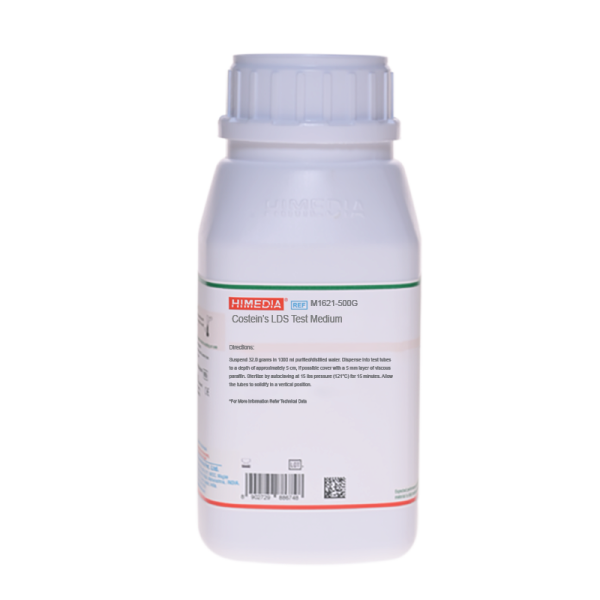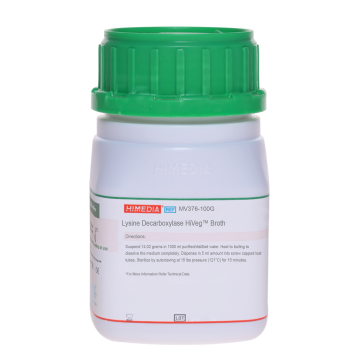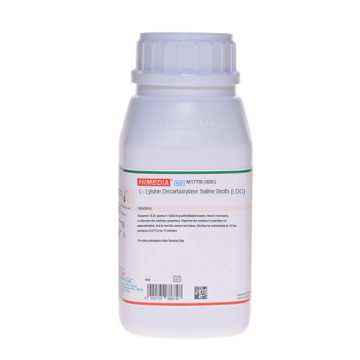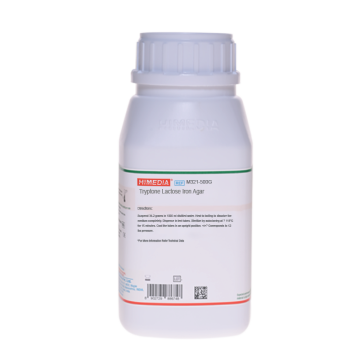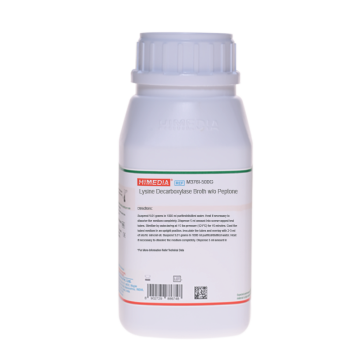 Your enquiry has been submitted
Your enquiry has been submitted
Costein’s LDS Test Medium
Intended Use
Costeins LDS Test Medium is employed for the identification of members of Enterobacteriaceae on the basis of lysine decarboxylase and hydrogen sulphide production.
Composition**
| Ingredients | Gms / Litre |
|---|---|
| Meat peptone | 4.500 |
| Papaic digest of soyabean meal | 2.000 |
| Yeast extract | 3.000 |
| Sodium chloride | 5.000 |
| D-Glucose | 1.000 |
| L-Lysine monohydrochloride | 10.000 |
| Sodium thiosulphate | 0.200 |
| Ammonium iron (II) sulphate | 0.200 |
| Bromocresol purple | 0.032 |
| Agar | 6.000 |
Final pH (at 25°C): 5.6±0.2
**Formula adjusted, standardized to suit performance parameters
Directions
Suspend 32 grams in 1000 ml distilled water. Dispense into test tubes to a depth of approximately 5 cm, if possible cover with a 5 mm layer of viscous paraffin. Sterilize by autoclaving at 15 lbs pressure (121°C) for 15 minutes. Allow the tubes to solidify in a vertical position.
Principle And Interpretation
Costeins LDS (Lysine Decarboxylase Sulfhydrase) Test Medium is formulated by Costein (1). This is the test culture medium for the simultaneous detection of lysine decarboxylase (LDC) and hydrogen sulphide production (2). Pietzsch recommended this medium on account of its high degree of reliability (3).
Meat peptone, papaic digest of soyabean meal and yeast extract in the medium provides nitrogen and other nutrients necessary to support bacterial growth. Sodium chloride helps in maintaining osmotic balance. Bromocresol purple is the pH indicator. Sodium thiosulphate acts as a reducing agent and maintains a low oxygen tension in the medium. Enterobacteriaceae grows poorly at low pH; therefore, their growth is poor on this medium due to its low pH value of 5.6. LDC-positive species tend to neutralize the medium as a result of cadaverine production due to decarboxylation of lysine; the conditions for growth are thus improved and the pH indicator changes its colour from yellow to violet. Species which can also reduce thiosulphate to hydrogen sulphide, cause an additional blackening of the violet medium due to the precipitation of iron sulphide. LDC-negative species do not increase the pH value of the medium; the pH indicator does not undergo a colour change. Therefore growth of these microorganisms is poor and H2S positive species are thus unable to produce any hydrogen sulphide e.g. Citrobacter, Proteus vulgaris, Proteus mirabilis, Providentia, Enterobacter, Shigella show yellow coloured growth. LDC-positive and H2S positive organisms give black colour and may be surrounded by a violet zone e.g. Salmonella, Edwardsiella and others LDC-positive and H2S negative organism are violet in colour e.g. Escherichia, Klebsiella, Hafnia, Serratia and some rare Salmonella and others.
Quality Control
Appearance: Cream to yellow homogeneous free flowing powder
Gelling: Firm, comparable with 0.6 % Agar gel
Colour and Clarity of prepared medium: Yellow coloured, clear to slightly opalescent gel forms in tubes as slants
Reaction: Reaction of 3.2% w/v aqueous solution at 25°C. pH : 5.6±0.2
pH: 5.40-5.80
Cultural Response
M1621: Cultural characteristics observed after an incubation at 35-37°C for 24-48 hours.
| Organism | Inoculum (CFU) | Growth | Colour change of medium |
|---|---|---|---|
| Escherichia coli ATCC 25922 | 50-100 | good | violet |
| Serratia marcescens ATCC 14756 | 50-100 | good | violet |
| Salmonella Typhimurium ATCC 14028 | 50-100 | good | violet and black |
| Salmonella Enteritidis ATCC 13076 | 50-100 | good | violet and black |
| Salmonella Arizonae ATCC 13314 | 50-100 | good | violet and black |
| Shigella flexneri ATCC 12022 | 50-100 | fair | yellow |
| Citrobacter freundii ATCC 8090 | 50-100 | fair | yellow |
| Proteus mirabilis ATCC 29906 | 50-100 | fair | yellow |
| Proteus vulgaris ATCC 13315 | 50-100 | fair | yellow |
Storage and Shelf Life
Store below 30°C in tightly closed container and the prepared medium at 2 - 8°C. Use before expiry date on the label
Reference
- Costein I. D., 1968, Einzelnahrboden fur die biochemische Ausscheidung van Salmonella-und Arizona-Kulturen- Zbl. F. Bakt. I. Orig., 206:390-395.
- Edwards P. R., Fife M. A., 1961, Lysine-Iron Agar in the detection of Arizona cultures, Appl. Microbiol., 9:478-480.
- Pietzch O., 1975, Der Voges-Proskauer- Schnelltest und der Lysindecarboxylase-Sulfhydrase-Test, Zwei Schnellmethoden fur die Enterobacteriaceae Diagnostik., - Arch. lebensmittelhyg., 26: 23-24.
| Product Name | Costein’s LDS Test Medium |
|---|---|
| SKU | M1621 |
| Product Type | Regular |
| Physical Form | Powder |
| Origin | Animal |
| Packaging type | HDPE |
| References | 1.American Public Health Association, Standard Methods for the Examination of Dairy Products, 1978, 14th Ed.,Washington D.C.2.Baird R.B., Eaton A.D., and Rice E.W., (Eds.), 2015, Standard Methods for the Examination of Water and Wastewater,23rd ed., APHA, Washington, D.C.3.Costein I. D., 1968, Einzelnahrboden fur die biochemische Ausscheidung van Salmonella-und Arizona-Kulturen- Zbl.F.Bakt. I. Orig., 206:390-395. |
| Customized Product Available | No |



